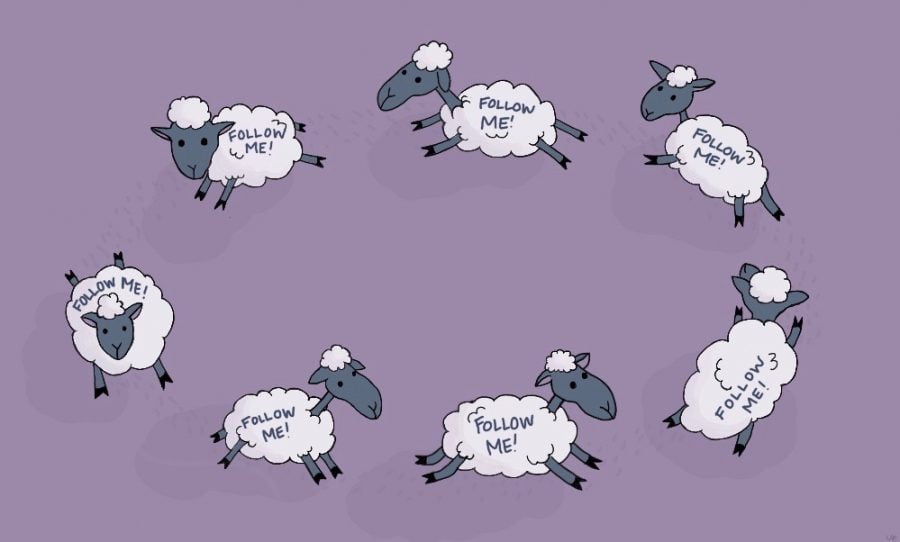The harmonization between a person’s behaviour and the standards of a particular group. It is best to use the term ‘norms‘ as opposed to standards. Norms can refer to certain practices, beliefs, expectations or desires. A person conforms when he/she seeks to adopt the same behaviour, beliefs, attitudes and practices of those in the group. Take a group of teens, for example, owing to peer pressure and the desire to ‘fit in’, most teens tend to conform to the practice and behaviour of the group they associate with. These behavioural traits and practices can be seen as unwritten rules that guide this group in their day-t o-day lifestyle, at school or among society. As opposed to a state of Compliance, Conformity is not prescribed by a legal body. In fact, refusal to conform is viewed as independence or rebellion. If a person does not conform to certain social norms or conventions, they face rejection. Conformity stems from the need to feel accepted, to avoid rejection and thereby seek security within a particular group. Of course, this is just one aspect of Conformity. It can also refer to a situation in which things or people correspond in nature or appearance. Conformity represents the act of congruity. Simply put, Conformity means doing what everyone else is doing. It is a choice.
Conformity can also be simply defined as “yielding to group pressures” (Crutchfield, 1955). Group pressure may take different forms, for example bullying, persuasion, teasing, criticism, etc. Conformity is also known as majority influence (or group pressure).
The term conformity is often used to indicate an agreement to the majority position, brought about either by a desire to ‘fit in’ or be liked (normative) or because of a desire to be correct (informational), or simply to conform to a social role (identification).
Jenness (1932) was the first psychologist to study conformity. His experiment was an ambiguous situation involving a glass bottle filled with beans.
He asked participants individually to estimate how many beans the bottle contained. Jenness then put the group in a room with the bottle, and asked them to provide a group estimate through discussion.
Participants were then asked to estimate the number on their own again to find whether their initial estimates had altered based on the influence of the majority.
Jenness then interviewed the participants individually again, and asked if they would like to change their original estimates, or stay with the group’s estimate. Almost all changed their individual guesses to be closer to the group estimate.
Compliance (or group acceptance)
This occurs ‘when an individual accepts influence because he hopes to achieve a favorable reaction from another person or group. He adopts the induced behavior because….he expects to gain specific rewards or approval and avoid specific punishment or disapproval by conformity’ (Kelman, 1958, p. 53).
In other words, conforming to the majority (publicly), in spite of not really agreeing with them (privately). This is seen in Asch’s line experiment.
Compliance stops when there are no group pressures to conform, and is therefore a temporary behavior change.
Internalization (genuine acceptance of group norms)
This occurs ‘when an individual accepts influence because the content of the induced behavior – the ideas and actions of which it is composed – is intrinsically rewarding. He adopts the induced behavior because it is congruent [consistent] with his value system’ (Kelman, 1958, p. 53).
Internalization always involves public and private conformity. A person publicly changes their behavior to fit in with the group, while also agreeing with them privately.
This is the deepest level of conformity were the beliefs of the group become part of the individual’s own belief system. This means the change in behavior is permanent. This is seen in Sherif’s autokinetic experiment.
This is most likely to occur when the majority have greater knowledge, and members of the minority have little knowledge to challenge the majority position.
Identification (or group membership)
This occurs ‘when an individual accepts influence because he wants to establish or maintain a satisfying self-defining relationship to another person or group’ (Kelman, 1958, p. 53).
Individuals conform to the expectations of a social role, e.g. nurses, police officers. It is similar to compliance as there does not have to be a change in private opinion. A good example is Zimbardo’s Prison Study.
Man (1969) identified an additional type of conformity:
Ingratiational
This is when a person conforms to impress or gain favor/acceptance from other people.
It is similar to normative influence, but is motivated by the need for social rewards rather than the threat of rejection, i.e., group pressure does not enter the decision to conform.
Explanations of Conformity
Deutsch and Gerrard (1955) identified two reasons why people conform:
- Yielding to group pressure because a person wants to fit in with the group. E.g. Asch Line Study.
- Conforming because the person is scared of being rejected by the group.
This type of conformity usually involves compliance – where a person publicly accepts the views of a group but privately rejects them.l Conformity
This usually occurs when a person lacks knowledge and looks to the group for guidance.
Or when a person is in an ambiguous (i.e. unclear) situation and socially compares their behavior with the group. E.g. Sherif’s Study.
This type of conformity usually involves internalization – where a person accepts the views of the groups and adopts them as an individual.
Sherif (1935) Autokinetic Effect Experiment
Aim: Sherif (1935) conducted an experiment with the aim of demonstrating that people conform to group norms when they are put in an ambiguous (i.e. unclear) situation.
Method: Sherif used a lab experiment to study conformity. He used the autokinetic effect – this is where a small spot of light (projected onto a screen) in a dark room will appear to move, even though it is still (i.e. it is a visual illusion).
It was discovered that when participants were individually tested their estimates on how far the light moved varied considerably (e.g. from 20cm to 80cm).
The participants were then tested in groups of three. Sherif manipulated the composition of the group by putting together two people whose estimate of the light movement when alone was very similar, and one person whose estimate was very different. Each person in the group had to say aloud how far they thought the light had moved.
Results: Sherif found that over numerous estimates (trials) of the movement of light, the group converged to a common estimate. The person whose estimate of movement was greatly different to the other two in the group conformed to the view of the other two.
Sherif said that this showed that people would always tend to conform. Rather than make individual judgments they tend to come to a group agreement.
Conclusion: The results show that when in an ambiguous situation (such as the autokinetic effect), a person will look to others (who know more / better) for guidance (i.e. adopt the group norm).
They want to do the right thing, but may lack the appropriate information. Observing others can provide this information. This is known as informational conformity.
Non Conformity
Not everyone conforms to social pressure. Indeed, there are many factors that contribute to an individual’s desire to remain independent of the group.
For example, Smith and Bond (1998) discovered cultural differences in conformity between western and eastern countries. People from Western cultures (such as America and the UK) are more likely to be individualistic and don’t want to be seen as being the same as everyone else.
This means that they value being independent and self sufficient (the individual is more important than the group), and as such are more likely to participate in non conformity.
In contrast, eastern cultures (such as Asian countries) are more likely to value the needs of social groups before their own. They are known as collectivist cultures and are more likely to conform.
Difference Between Compliance and Conformity
At first it may seem that ‘to conform’ and ‘to comply’ essentially mean the same thing, notably, to agree to do something or follow certain rules. However, the strict definitions of these two terms illustrate something different entirely.
The term Compliance at the very outset portrays a somewhat formal, serious type of act. It is defined as the act or process of adhering to and fulfilling a given order or command. Compliance denotes a situation wherein certain rules or orders have been met. Think of it as a situation in which an individual has carried out the commands or orders of another individual, most often a State organization or legal body. Compliance then means that the person fulfilling the order did not have a choice in the matter. Thus, the individual carried out the order with a foreknowledge of the consequences in refusing to fulfill that order. For example, if a company fails to comply with certain regulations, such as environmental regulations, it will be subject to the imposition of fines or other legal penalties. To avoid such a consequence, the company will no doubt comply with the prescribed regulation. Similarly, restaurants have to comply with certain policies and specifications when providing food, beverages and other related services. Simply put, Compliance ensures that there is order and protection in society. The opposite of Compliance, which is non-Compliance, results in serious consequences although in some instances this is not so.
- Compliance denotes a situation in which a person fulfills an order or rule stipulated by a legal authority. Conformity, on the other hand, refers to when a person behaves or acts according to certain social norms of a group.
- Compliance is fulfilled in fear of the penalties that follow in the event there is no Compliance. Conformity, however, is carried out by a desire to ‘fit in’. Failure to conform results only in rejection.
- Compliance often is compulsory; Conformity is more of a choice.
Sources:
- https://www.simplypsychology.org/conformity.html
- https://www.differencebetween.com/difference-between-compliance-and-vs-conformity/
Learn More: Watch Video:




